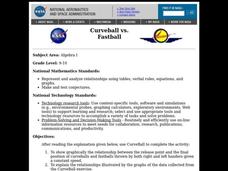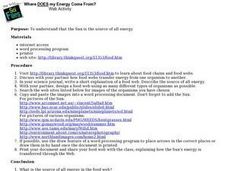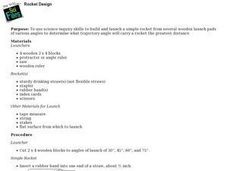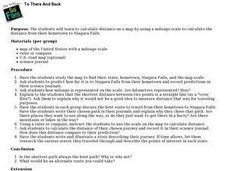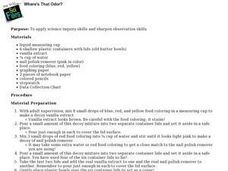Curated OER
Gas Properities Definitions
Students, after reading the Web page Gas Properties Definitions, complete the activity to demonstrate an understanding of the properties of gases.
Curated OER
Thrust to Weight Ratio
Students, after reading the Web page Thrust to Weight Ratio, use Range Games and the Air Page to complete the activity to answer questions about turbojet thrust to weight ratio.
Curated OER
Curveball vs. Fastball
Students graph the relationship between the release point and the final position of curveballs and fastballs thrown by both right and left handers given a constant speed, and explain the relationships illustrated by the graphs of data.
Curated OER
Mass & Velocity Effect
Students, after reading the explanation given below, use FoilSim to complete the activity to fulfill the specifications of a given airfoil and then plot and interpret graphs.
Curated OER
Experiment: Faster Air = Lower Air Pressure 2
Students experiment to observe air current and pressure.
Curated OER
Stars and Slopes
Young scholars use the slopes of various curves plotted on log-log graph paper to classify stellar objects as binary stars, supernovae, or active galaxies.The data used in this instructional activity were obtained from X-ray astronomy...
Curated OER
Solar Storms
Students investigate the cycles of solar activity. They plot the solar activity and use the graph to answer a number of questions and explain the relationship between the solar storms and sunspots and the impact on earth and space travel.
Curated OER
Where Does My Energy Come From?
Learners gain an understanding that the Sun is the source of all energy. With a partner, they examine various web sites to explore food chains and food webs, later sharing their findings with the class.
Curated OER
Finding the Flu
Students work to determine when the flu is most prevalent in the United States. They gather data on their own, create calendar, charts, and graphs, analyze their findings and present them. This is a very appropriate winter lesson!
Curated OER
Earthquake Analysis
Students analyze and plot the coordinates for several recent earthquakes on a world map. They learn not only about research and geology, but about map-making and data analysis. They think of other ways to analyze the data given.
Curated OER
How Sweat Glands Cool Your Body
Students use water and rubbing alcohol to explain how sweat cools mammals' bodies. They write their findings in a journal. After a lecture/demo, students perform a simple experiment that demonstrates this phenomenae.
Curated OER
Wish You Were Here - Research Conditions on Mars
High schoolers research conditions on Mars, then create a travel brochure or presentation to attract tourists. They work in cooperative groups. Each member is assigned a different role and contribute specific information to the group's...
Curated OER
Rocket Design: Aerodynamics, Trajectories
Students use science inquiry skills to build and launch a simple rocket, from several wooden launch pads of various angles, to determine what trajectory angle carry a rocket the greatest distance.
Curated OER
What's That Smell?
Students experiment with different scents (vanilla, peppermint, perfumes etc.) to explore their sense of smell.
Curated OER
To There And Back
Students calculate distance on a map by using a mileage scale to calculate the distance from their hometown to Niagara Falls. They, in groups, determine the best route, then compose stories about their journey to Niagra Falls.
Curated OER
Aviation Pioneers
Students research the Wright Brothers historic first flight and design a travel poster asking for volunteers to participate. Write a newspaper account of the first flight and include how the local people may have felt about the Wright...
Curated OER
Where's That Odor?
Students use various substances to experiment with odors and their potency. They sharpen their observational skills.
Curated OER
Dancing Paper: Static Charge, Science
Students use glass, plastic, paper and various other materials to investigate the properties of static charge and develop scientific inquiry skills.
Curated OER
Volcanic Wrath
Students observe volcanic action using an internet Web site of satellite photographs. Stuents create a portfolio of observable features.
Curated OER
Geographic Information Systems
Young scholars examine the concept of geographic information systems (GIS) and its basic components. They explore an application program using GIS technology and list the various uses for GIS.
Curated OER
Circle the Earth - Explore Surface Types on a Journey around Earth
Students use CERES percent coverage surface data with a world map in locating landmasses and bodies of water at Earth's Equator.
Curated OER
Robots from Junk
Students create balloon and rubber band models of robotic rovers to investigate the concepts of mass, torque, and friction. Through research and planning, students construct a rover test-bed that simulates the Martian environment.
Curated OER
Observing Mars in the Night Sky
Students compare and contrast the orbits of Earth and Mars, locate the planet Mars, and diagram its retrograde motion.
Curated OER
Reading the Shapes of Volcanoes on Earth and Mars
Learners compare and contrast the volcanoes of Earth and Mars, and examine specific volcanoes on Mars. They model the processes that create cone and shield volcanoes, and measure the slope angles of cone and shield volcanoes.
Other popular searches
- Nasal Passages
- About Nasa
- Nasa Planets
- Nasa Robots
- Nasa Lesson Math
- Nasa Aircraft
- Nasa Materials
- History of Nasa
- Nasa Lesson Plans
- Nasa Web Based Textbook
- Nasa Aurora
- Contributions of Nasa




